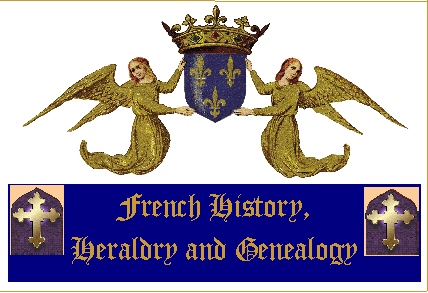

Peter Bartholomew - French Crusader
Just recently, while researching for information on the Crusades, I came upon a Bartholomew connection in France. This is new, so I haven't got much information. However, a Peter Bartholomew is written up in the book God Wills It. It states the following:
Peter Bartholomew claimed that Christ had visited him and told him that the lance that pierced Christ's side, at his Crucifixion, was buried beneath the cathedral floor in Antioch. They did find a small piece of metal there that could have been a part of a spear. However, most thought it was a hoax, which had been perpetrated to boost the spirits of the Crusaders. Adhemar was sceptical of Peter Bartholomew's story. Peter, however, genuinely believed in the divine origin of his visions.
On Good Friday, Peter agreed to undertake a trial by fire. He was to walk through two burning piles of blazing logs. By the time he completed his ordeal, he was badly burned on his feet and legs.
Peter Bartholomew only lived for eleven (11) days after this and suffered much pain and agony over the act. At his death, Peter told of his vision about Adhemar being in hell for a short time, because he did not believe Peter's story. This antagonized members and supporters of Adhemar. His last vision, before this one, was that the army must attack Arga immediately. By this point everyone was convinced Peter was a charleton. Bartholomew's death was his only salvation. This event was said to have changed the mood of the Crusade. Some believe he had truly had a vision from God.
Peter was seen as being closely allied to Raymond, and his oppenents saw the latest action merely as a cynical ploy. to ensure that the city fell into Raymond's hands. The northern French openly declared their disbelief in Peter's visions. However, several prelates came to Peter's defense. Priest Peter Desiderius also had a vision where he spoke to Adhemar, who castigated the Franks for petty squabbles. He ordered that the army should fast in penitence for their sins.
RAYMOND IV OF ST. GILLES, COUNT OF TOULOUSE AND MARQUISE DE PROVENCE :
The Count of Toulouse had not sworn allegience to the Emperor of Byzantium, as did Bohemond. Bohemond got Antoich for his loyalty, even though the armies of both Bohemond and Raymond captured the city together.
Provence was located between the mountains of France and the Pyrennes in southern France. Since Raymond's other title was Marquis be Provence and this was in southern France it would seem likely that this is why those in north France had issues against Raymond. A sort of rivalry was taking place.
To get to Jerusalem the Crusaders would have to travel 2,500 miles. Raymond had an estimated 30,000-40,000 men, depending on which written account you believe. However, a letter to Pope Urban mentions 300,000 men. The truth as most historians agree, is 30,000. By the time Raymond's army reached the Holy Lands these numbers fell to disease, hunger, thirst, casualties in action, and desertion.
One month before the Fall of Jerusalem, Tancred stated that only one man in ten remained alive.
By 1097, things were worse for the knights:
The infernal heat, glaring and blinding sun, and brackish water made this area a hell on earth,
(as reported byTancred, Count of Toulouse)
Raymond of Toulouse had men from Languedoc and Provence, and he garrisoned the main bridge at Antioch (June 1098). Rayomnd was one of the most important of the great French feudatories now on the march,. He was irked that he should be sent on a mission, while the prize of Antioch fell to a rival (Bohemond).
As I said earlier, it was thought that Peter Bartholomew and his visions were part of Raymond's conspiracy to gain more notoriety and perhaps nullify Bohemond's power and selfishness. Remember they should have shared Antioch's riches, as both men had basically depeted all their money by this point in the Crusade. Antioch offered many riches as it was a safe and prosperous place of commerce.
It was not until Febraury 8, 1198, that the Muslims attempted to recapture Antioch, as it was closely held by the Christians.
The Tower of the Two Sisters was located on the south side of the city of Antioch, and was a major defense station for Bohemond and his troops.
It is interesting that the Two Sisters have been compared to the Twin Towers of New York City, which is also a powerful area of trade and commerce. Even more startling is that the modern day attack and destruction of the Twin Towers would mean that this was symbolic of a battle that was fought 903 years before.
As a side note, Bishop of Le Puy, who fought with Raymond IV, Count of Toulouse's army, was wounded and captured. Raymond, Count of Toulouse was sixty-years old at the time of this Crusade. He was connected to the royal family of Spain. Another army that fought alongside of Raymond's army was that of Hugh, Count of Vermandois. Hugh was the son of King Henry I of France. Another leader was Godfrey, Count of Vermandois and Duke of Lower Lorraine, who claimed descent from King Charlesmagne.
Written and researched by Margaret Odrowaz-Sypniewska, B.F.A.In 1098, a "poor peasant" named Peter Bartholomew was:
SOURCES:
Belloc, Hilaire. The Crusades: The World's Debate. Rockford, IL.: Tan Books and Publishers, Inc. reprinted in 1992, 100.
 ...
...